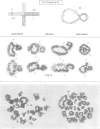Abstract
The meiotic behaviour of two male human reciprocal translocations is described. One patient had an unbalanced son and a chain configuration. The second had a stillborn child and a ring corresponding to an adjacent I segregation. The meiotic behaviour of chromosomal rearrangements must be investigated for proper genetic counselling.
Full text
PDF



Images in this article
Selected References
These references are in PubMed. This may not be the complete list of references from this article.
- Chandley A. C., Christie S., Fletcher J., Frackiewicz A., Jacobs P. A. Translocation heterozygosity and associated subfertility in man. Cytogenetics. 1972;11(6):516–533. doi: 10.1159/000130218. [DOI] [PubMed] [Google Scholar]
- Chandley A. C., Seuánez H., Fletcher J. M. Meiotic behavior of five human reciprocal translocations. Cytogenet Cell Genet. 1976;17(2):98–111. doi: 10.1159/000130694. [DOI] [PubMed] [Google Scholar]
- Chandley A. C. The chromosomal basis of human infertility. Br Med Bull. 1979 May;35(2):181–186. doi: 10.1093/oxfordjournals.bmb.a071567. [DOI] [PubMed] [Google Scholar]
- EVANS E. P., BRECKON G., FORD C. E. AN AIR-DRYING METHOD FOR MEIOTIC PREPARATIONS FROM MAMMALIAN TESTES. Cytogenetics. 1964;3:289–294. doi: 10.1159/000129818. [DOI] [PubMed] [Google Scholar]
- Evans J. A., Canning N., Hunter A. G., Martsolf J. T., Ray M., Thompson D. R., Hamerton J. L. A cytogenetic survey of 14,069 newborn infants. III. an analysis of the significance and cytologic behavior of the Robertsonian and reciprocal translocations. Cytogenet Cell Genet. 1978;20(1-6):96–123. doi: 10.1159/000130843. [DOI] [PubMed] [Google Scholar]
- Ford C. E., Clegg H. M. Reciprocal translocations. Br Med Bull. 1969 Jan;25(1):110–114. doi: 10.1093/oxfordjournals.bmb.a070659. [DOI] [PubMed] [Google Scholar]
- Gallimore P. H., Richardson C. R. An improved banding technique exemplified in the karyotype analysis of two strains of rat. Chromosoma. 1973;41(3):259–263. doi: 10.1007/BF00344020. [DOI] [PubMed] [Google Scholar]
- Jacobs P. A., Frackiewicz A., Law P. Incidence and mutation rates of structural rearrangements of the autosomes in man. Ann Hum Genet. 1972 Mar;35(3):301–319. doi: 10.1111/j.1469-1809.1957.tb01403.x. [DOI] [PubMed] [Google Scholar]
- Jalbert P., Sele B., Jalbert H. Reciprocal translocations: a way to predict the mode of imbalanced segregation by pachytene-diagram drawing. Hum Genet. 1980;55(2):209–222. doi: 10.1007/BF00291769. [DOI] [PubMed] [Google Scholar]
- LINDSTEN J., FRACCARO M., KLINGER H. P., ZETTERQVIST P. MEIOTIC AND MITOTIC STUDIES OF A FAMILIAL RECIPROCAL TRANSLOCATION BETWEEN TWO AUTOSOMES OF GROUP 6-12. Cytogenetics. 1965;4:45–64. doi: 10.1159/000129843. [DOI] [PubMed] [Google Scholar]
- Laurent C., Biemont M. C., Cognat M., Dutrillaux B. Studies of the meiotic behavior of a translocation t(10;13)(q25;q11) in an oligospermic man. Hum Genet. 1977 Nov 2;39(1):123–126. doi: 10.1007/BF00273162. [DOI] [PubMed] [Google Scholar]
- Lindenbaum R. H., Bobrow M. Reciprocal translocations in man. 3:1 Meiotic disjunction resulting in 47- or 45-chromosome offspring. J Med Genet. 1975 Mar;12(1):29–43. doi: 10.1136/jmg.12.1.29. [DOI] [PMC free article] [PubMed] [Google Scholar]
- Miró R., Templado C., Ponsá M., Serradell J., Marina S., Egozcue J. Balanced translocation (10;13) in a father, ascertained through the study of meiosis in semen, and partial trisomy 10q in his son. Characterization of the region responsible for the partial trisomy 10q syndrome. Hum Genet. 1980 Feb;53(2):179–182. doi: 10.1007/BF00273492. [DOI] [PubMed] [Google Scholar]
- Polani P. E., Mutton D. E. Y-fluorescence of interphase nuclei, especially circulating lymphocytes. Br Med J. 1971 Jan 16;1(5741):138–142. doi: 10.1136/bmj.1.5741.138. [DOI] [PMC free article] [PubMed] [Google Scholar]
- Román C. S., Sordo M. T., García-Sagredo J. M. Meiosis in two human reciprocal translocations. J Med Genet. 1979 Feb;16(1):56–59. doi: 10.1136/jmg.16.1.56. [DOI] [PMC free article] [PubMed] [Google Scholar]
- Scheres J. M., Hustinx T. W. Heritable fragile sites and lymphocyte culture medium containing BrdU. Am J Hum Genet. 1980 Jul;32(4):628–629. [PMC free article] [PubMed] [Google Scholar]
- Sperling K., Kaden R. Meiotic studies of the ejaculated seminal fluid of humans with normal sperm count and oligospermia. Nature. 1971 Aug 13;232(5311):481–481. doi: 10.1038/232481a0. [DOI] [PubMed] [Google Scholar]
- Sutherland G. R., Baker E., Seshadri R. S. Heritable fragile sites on human chromosomes. V. A new class of fragile site requiring BrdU for expression. Am J Hum Genet. 1980 Jul;32(4):542–548. [PMC free article] [PubMed] [Google Scholar]
- Templado C., Marina S., Coll M. D., Egozcue J. Meiotic studies in human semen. Report of 180 cases. Hum Genet. 1980;53(3):335–339. doi: 10.1007/BF00287052. [DOI] [PubMed] [Google Scholar]




